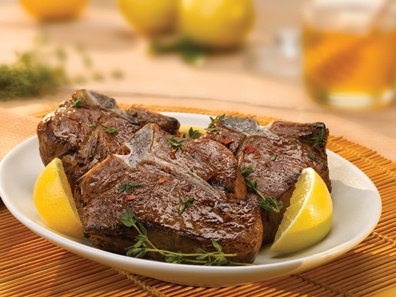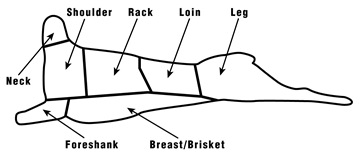Lesson Plan: American Lamb—from Shepherd to Chef
Super UserBy Megan Wortman
 From the American Lamb Board, a primer that covers everything from U.S. sheep production to menuing lamb.
From the American Lamb Board, a primer that covers everything from U.S. sheep production to menuing lamb.
Sheep are one of the world’s oldest domesticated animals, raised for fleece, meat (lamb or mutton) and milk. Not surprisingly, lamb remains prevalent in the diets and dining rooms of most every region and culture of the globe.
Now, more than ever, there is an interest in the manner our food is raised and the number of miles it must travel to get to our tables. The American sheep industry is committed to quality and epitomizes this local food movement.
U.S. Sheep Production
Sheep are raised in every state in the country and the people who raise sheep are as varied as the regions they call home. There are an estimated 82,000 sheep operations in the United States, the majority of them family owned and operated. While some producers have farm flocks between 50 and 299 animals, others have large operations ranging from 1,000 to 10,000 sheep. Texas, California, Colorado, Wyoming and South Dakota lead the states in sheep production.
Sheep producers care for their sheep by making sure they have natural grazing, a clean water source and protection from predators. Sheep are herbivores. Their ideal pasture includes an array of grasses, legumes, weeds and brushy plants. Depending on the quality of the range, some lambs are marketed directly from the range or pasture, while others are grain-finished for a short period of time.
The grazing skills of sheep have some interesting uses. Sheep help to prevent forest fires by clearing undergrowth in forests and wooded areas. Wineries also use sheep to graze weeds in the vineyards naturally.
Shepherds tend to their flocks with the help of guard dogs. Guard dogs help to protect the sheep and other livestock from coyotes, black bears and mountain lions.
No artificial growth hormones are used in lamb production in the United States.
Lamb Versus Mutton
As sheep age, their meat becomes stronger in taste and firmer in texture. Lamb is meat from sheep that are less than one year of age. Meat from a sheep older than one year of age is considered mutton.
As a result of superior breeding which focuses on meat rather than wool production and nutritional programs, American Lamb is now milder and more delicate in flavor and available year round.
The USDA Economic Research Service estimates that Americans eat less than a pound (0.8 lb.) of lamb annually compared to nearly 40 pounds per capita consumption in New Zealand.
American Lamb Inspection and Grading
All American Lamb is inspected for wholesomeness by the USDA or state organizations which have standards equal to those of the federal government.
For American Lamb, the USDA has set five quality grades:
- Prime
- Choice
- Good
- Utility
- Cull
These quality grading classifications are based on maturity/age, conformation (carcass shape, form and outline) and other lean quality factors. The USDA also has established yield grades that reflect the quantity of cuts that can be expected from a lamb carcass. More than 90 percent of American Lamb will grade USDA choice or Prime.
Primals and Subprimals
Lamb is cut into four major primal cuts: shoulder, rack, loin and leg. Subprimals include the neck, foreshank, breast/brisket and flank.

Lamb Nutrition
Lamb is naturally nutrient rich.
Compared to other meats, the fat on lamb is often on the outside edges and thus is easily trimmed. On average, a 3-ounce serving of lamb has just 175 calories and meets the Food and Drug Administration’s definition of lean.
On average, a 3-ounce serving of cooked lean American Lamb is an excellent source of:
- Protein (47% DV)
- Vitamin B12 (36% DV)
- Niacin (26% DV)
- Selenium (38% DV)
- Zinc (32% DV)
Lamb is also a good source of iron and riboflavin.
Cooking Lamb
Lamb should be juicy and tender when cooked. Tender lamb cuts should be prepared using dry heat cooking methods – roasting, broiling, grilling or pan-frying. Less tender cuts are best prepared using moist heat cooking methods such as braising.
The USDA recommends that ground lamb should be cooked to an internal temperature of 160°F. Other cuts including chops and roasts should be cooked to 145°F for medium-rare to 170°F for well done. Lamb, like all meats, should rest for about 5 to 10 minutes before slicing and serving. Keep in mind that its temperature will rise about 5 to 10 degrees during this time, so lamb roasts should be removed from oven just before desired doneness registers on meat thermometer.
Lamb on the Menu
Approximately 75% of all fine dining restaurants feature lamb on their menus. The most popular cuts menued include the classic rack of lamb as well as chops, shanks and loins. Grilling, braising and roasting represent the most popular cooking methods for lamb.
While lamb is most prevalent on fine dining menus, lamb is also menued at several ethnic restaurants. Popular menu items include gyros and kebabs.
The American Lamb Board offers several culinary education tools for educators—from cuts posters to step-by-step fabrication sheets to DVDs. For more information about these materials and further information about American Lamb—from Shepherd to Chef, visit www.americanlamb.com.
About the American Lamb Board
The American Lamb Board is an industry-funded research and promotions commodity board that represents all sectors of the American Lamb industry including producers, feeders, seed stock producers and processors. The Board, appointed by the Secretary of Agriculture, is focused on increasing demand by promoting the freshness, flavor, nutritional benefits, and culinary versatility of American Lamb. The work of the American Lamb Board is overseen by the U.S. Department of Agriculture and the board's programs are supported and implemented by the staff in Denver, Colo.
Megan Wortman is executive director of the Denver-based American Lamb Board.
Photo caption: American Lamb Chops with Lemon/Honey/Thyme Marinade.
Leave a comment
Make sure you enter all the required information, indicated by an asterisk (*). HTML code is not allowed.

